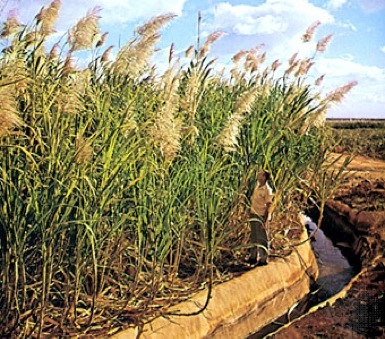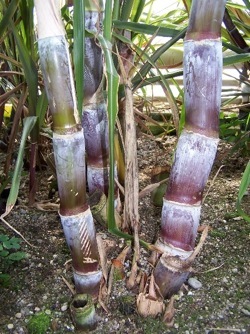Saccharum officinarum: Sweet Wild Weed
Among the edible wild plants on this site are a few escaped fruit trees and ornamentals that have become naturalized. Let’s add another: Sugarcane.
I’ve grown sugar cane for several years in my yard, neglecting it actually. It grows happily just the same despite the fact I am more than 200 miles north of south Florida and on a dry hill. So that is the first surprise about sugarcane or Saccharum officinarum. It’s a tropical and subtropical plant, found from Florida to Texas as well as Puerto Rico and Hawaii. One does encounter it growing in the wild. It looks like very tall corn that has mated with bamboo.
Sugarcane is actually a grass, a big grass — note the man in the picture above — and a perennial. There are a half dozen to three dozen species — botanists can’t agree –but that is kind of forgivable. Grasses are notoriously difficult to sort out, even when you know what it is. If you think it’s tough identifying mushrooms, try grasses for a real challenge.
Let me give you two estimates which as first would seem wrong. There are about 195 countries in the world, and about 195 countries grow sugar cane. That’s can’t be because places like Canada and Sweden don’t grow sugarcane. There is a two part explanation. The official number of countries is usually based on the membership in the United Nations. But several countries are not in the United Nations. Also sugar producers call some places countries that are not really countries, such as Puerto Rico and Bermuda. So two different measuring standards come up with the same answer — 195 — but their list of “countries” would be slightly different.
And while sugar cane is really mostly sugar — it is one of the most efficient plants there are — that’s not always a bad thing. In fact, sugarcane was included in military survival manuals because it is nearly impossible to misidentify and it does provide portable energy. You can use a stalk of it (a cane) as a walking stick and for food. You chew the end but spit out the fiber called bagasse (bah-GAS.) Once dry, bagasse burns well.
The clear sugar sap after processing is brown sugar, hence brown sugar is less processed sugar. Then it is bleached white. Also one can never get all of the sugar out of the sap and that becomes molasses, one of my grandmother’s preferred sweetener. She never used white sugar in her life. Any time anything called for sugar in went the molasses.
Sugarcane is probably from the area of India originally. Granular sugar was mentioned in writing some 5,000 years ago. It got to the Mediterranean Basin around 800 AD. Within 200 years there was hardly a village there that was not growing sugar cane. A sweet tooth is the one craving humans are born with. Sugarcane came to the New World some five hundred years later where it played a significant and controversial role, and still does.
Historical fact: Sugar was one of the first pharmaceutical ingredients, a sweetener to mask bitter medicine, hence the lyric… “a little bit of sugar helps the medicine go down.” There are generally three kinds of sugar cane grown, “chewing cane” “crystal cane” and “syrup cane.”
Saccharum officinarum (SAK-har-um of-fee-shee-NAR-um) means “sugar of the shops.” Officinarum comes from Latin and the Romans. Government-approved food and medicine in the Roman Empire were sold in designated shops. It was a standard of quality. Thus something sold in a shop was what we would call the authorized version, or the official version, the real McCoy. (See my article on Palmetto Weevils.)
Green Deane’s “Itemized” Plant Profile
IDENTIFICATION: Giant grass, eight to 20 feet, resembles corn, solid, jointed, juicy stalks, one to two inches thick, tough. Leaves three feet or more long, two to 2.5 inches wide, thick midrib, fine sharp teeth on the edges. Spikelet are white, hairy, plume like, two to three feet long. Can grow straight up or fall over.
TIME OF YEAR: This year’s sugar cane is usually harvested in November, but in a wild stand, nearly year round.
ENVIRONMENT: Moist, low areas as well as abandoned cultivations particularly in the Everglades.
METHOD OF PREPARATION: Stems are peeled and chewed for the juice. Or, they can be peeled, crushed and boiled for the syrup. Once a sweet syrup is obtained, or sugar, it can be used for many things, from making wine to fuel.




I remember chewing sugar cane in India as a child. We also drank freshly squeezed sugar cane juice, a green foamy liquid, on hot days, as a super thirst quencher. The juice is recommended to cure Jaundice.
Love your web site .
Keep sharing your knowledge……..I soak it up. It’s like reading a good book and then meeting the characters as you walk around doing the daily grind 🙂
– Kitty, Boca Raton, FL
I chewed sugar cane too when it was grown here but I don’t think it likes the cold as there are no longer any here that I know of but it is being grown like crazy down toward Ft. Lauderdale and Miami. I don’t see any being grown here this far north of Lake Okeechobee or in the wild.
I wish we had River Cane or Giant Cane Arundinaria gigantea this far south. Very useful cane. Not sure if its edible or not. Any ideas on that, Deane? Thanks.
One can get sugar cane to grow here in central Florida. As for the Arundinaria gigantea young shoots are edible raw.
[quote]One can get sugar cane to grow here in central Florida.[/quote]
Yes it will grow here but I don’t think it can stand the cold so that is why I think folks don’t have it here where I live anymore. That is what I was trying to say.
[quote]As for the Arundinaria gigantea young shoots are edible raw.[/quote]
Thanks
I have been growing sugar cane in my backyard since I went to Christmas FL up on Rt. 50 (East Colonial Dr.) to their Christmas Festival. They had a demonstration where they were grinding the cane and boiling the cane syrup.
It is grown here. If you want sugar cane go to a store on E. Colonial or on S. Goldenrod Rd. named Fancy Fruit and Produce.
You get the canes. Cut them where they have two nodes each. Place them in a glass of water for a couple of days until the roots start on the bottom nodes and then plant those with the top of the plant barely out of the ground and the roots on the bottom.
OR, you can take the entire cane and dig a furrow and plant it a couple of inches below the surface (about 6 inches). You will get plants coming off of each one node.
My neighbor grows a different kind of cane and we just recently traded. His is green. Mine is red. Both of them grow very well.
The frost got my beans but didn’t kill the sugar cane.
I am interested in growing sugar cane in a oblong pot outside a window which onlooks the pool area and is in full sun. Im not wanting it to grow over the eaves and am wondering if you think or could suggest a suitable variety that would suit my requests and I am also hopeing that it creates a bit of shade in the summer. Could you please advise, if you are able to assist. Regards
Donna
Poor soil would reduce it growth. As for shade, sugar can is not a good plant to produce shade.
I live in Deland fla-volusia county-i grow several kinds of bamboo but my sugarcange out grows all of them including the running types
Excuse the interruption, but I saw your post and I have been looking for a piece of sugar cane to grow in my backyard here in Citrus County Homosassa. Would you be willing to let me buy a piece from you that I can pot and get to grow. I cannot find any to purchase. Thank you.
No need for that. You can find them in Hispanic and Jamaican markets.
I grow sugarcane and will give you a stock you can plant . I live in Homosassa a mile from 19 call me 512-800-5587
Here in Louisiana sugarcane is grown well north of the 31st parallel (the border between Florida and Alabama is the 31st parallel). As long as you don’t have a hard freeze after the cane has started putting up shoots it should be fine. The particular variety might make a difference as well.
I was raised just south of Gainesville, Florida and we always raised sugar cane (Daddy got it from Cuba. We made syrup every fall & had to huge cooking kettles to cook the juice in. On the morning of the first freeze before the sun hit the cane we topped the tops off and took the rest of the day banking it and the next week grinding and cooking the syrup. We planted in the bottom land about 10 acres each year.
is sugercane invasive?
Several people in and near Meadows Place, Texas, Latitude 29.65 N grow Sugar Cane. It dies back during a freeze then sprouts out in the spring.